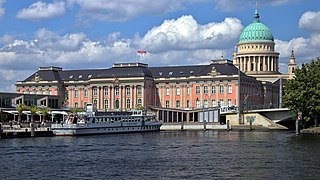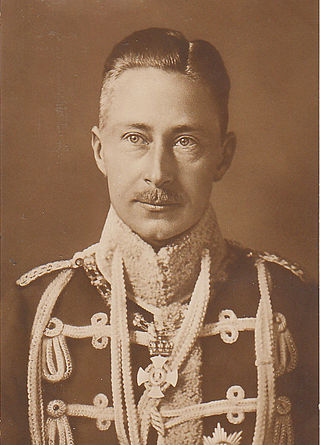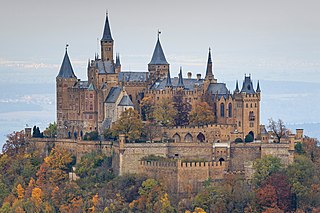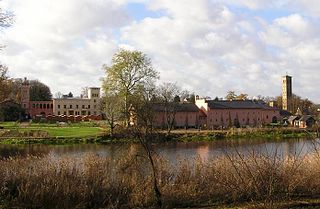
The House of Hohenzollern is a formerly royal German dynasty whose members were variously princes, electors, kings and emperors of Hohenzollern, Brandenburg, Prussia, the German Empire, and Romania. The family came from the area around the town of Hechingen in Swabia during the late 11th century and took their name from Hohenzollern Castle. The first ancestors of the Hohenzollerns were mentioned in 1061.

Potsdam is the capital and, with around 183,000 inhabitants, largest city of the German state of Brandenburg. It is part of the Berlin/Brandenburg Metropolitan Region. Potsdam sits on the River Havel, a tributary of the Elbe, downstream of Berlin, and lies embedded in a hilly morainic landscape dotted with many lakes, around 20 of which are located within Potsdam's city limits. It lies some 25 kilometres southwest of Berlin's city centre. The name of the city and of many of its boroughs are of Slavic origin.

Wilhelm, German Crown Prince, Crown Prince of Prussia was the eldest child of the last Kaiser, Wilhelm II, German Emperor, and his consort Augusta Victoria of Schleswig-Holstein, and thus a great-grandson of Queen Victoria, and distant cousin to many British Royals, such as Queen Elizabeth ll. As Emperor Wilhelm's heir, he was the last Crown Prince of the German Empire and the Kingdom of Prussia, until the abolition of the monarchy.

Cecilienhof Palace is a palace in Potsdam, Brandenburg, Germany, built from 1914 to 1917 in the layout of an English Tudor manor house. Cecilienhof was the last palace built by the House of Hohenzollern that ruled the Kingdom of Prussia and the German Empire until the end of World War I. It is famous for having been the location of the Potsdam Conference in 1945, in which the leaders of the Soviet Union, the United Kingdom and the United States made important decisions affecting the shape of post World War II Europe and Asia. Cecilienhof has been part of the Palaces and Parks of Potsdam and Berlin UNESCO World Heritage Site since 1990.

Schloss Charlottenburg is a Baroque palace in Berlin, located in Charlottenburg, a district of the Charlottenburg-Wilmersdorf borough.

Carl Philipp Christian von Gontard was a German architect who worked primarily in Berlin, Potsdam, and Bayreuth in the style of late Baroque Classicism. Next to Knobelsdorff, he was considered the most important architect of the era of Frederick the Great of Prussia.

Hohenzollern Castle is the ancestral seat of the imperial House of Hohenzollern. The third of three hilltop castles built on the site, it is located atop Mount Hohenzollern, above and south of Hechingen, on the edge of the Swabian Jura of central Baden-Württemberg, Germany.

(Hans) Georg Wenzeslaus von Knobelsdorff was a painter and architect in Prussia.

The Roman Baths, situated northeast of the Charlottenhof Palace in the Sanssouci Park in Potsdam, reflect the Italiensehnsucht of its creator Frederick William IV of Prussia. Various classical Roman and antique Italian styles were melded into an architectural ensemble, created between 1829 and 1840.

The Protestant Church of Peace is situated in the Marly Gardens on the Green Fence in the palace grounds of Sanssouci Park in Potsdam, Germany. The church was built according to the wishes and with the close involvement of the artistically gifted King Frederick William IV and designed by the court architect, Ludwig Persius. After Persius' death in 1845, the architect Friedrich August Stüler was charged with continuing his work. Building included work by Ferdinand von Arnim and Ludwig Ferdinand Hesse also. The church is located in the area covered by the UNESCO World Heritage Site Palaces and Parks of Potsdam and Berlin.

The New Chambers is part of the ensemble of Sanssouci palace in Sanssouci Park, Potsdam, Germany. They were constructed for King Frederick the Great of Prussia from 1771 to 1775.

The Picture Gallery in the Sanssouci Park of Potsdam was built in 1755–64 during the reign of Frederick II of Prussia under the supervision of Johann Gottfried Büring. The Picture Gallery is situated east of the palace and is the oldest extant museum built for a ruler in Germany.

The New Palace is a palace situated on the western side of the Sanssouci park in Potsdam, Germany. The building was begun in 1763, after the end of the Seven Years' War, under King Friedrich II and was completed in 1769. It is considered to be the last great Prussian Baroque palace.

Duchess Cecilie Auguste Marie of Mecklenburg-Schwerin was the last German Crown Princess and Crown Princess of Prussia as the wife of Wilhelm, German Crown Prince, the son of German Emperor Wilhelm II.

Bornstedt is a borough of Potsdam, Germany. Located north of Sanssouci Park and the Orangery Palace, it is known for the Bornstedt Crown Estate, former residence of Princess Royal Victoria, and the Bornstedt Cemetery with numerous tombs of famous personages.

Monbijou Palace was a Rococo palace in central Berlin located in the present-day Monbijou Park on the north bank of the Spree river across from today's Bode Museum and within sight of the Hohenzollern city palace. Heavily damaged in World War II, the ruins were finally razed by the authorities of East Berlin in 1959. The palace has not been rebuilt.

Prince Wilhelm Friedrich Franz Joseph Christian Olaf of Prussia was the eldest child of Wilhelm, German Crown Prince, and Duchess Cecilie of Mecklenburg-Schwerin. At his birth, he was second in line to the German throne and was expected to succeed to the throne after the deaths of his grandfather, Emperor Wilhelm II, and his father, Crown Prince Wilhelm. Both, however, outlived him.

The Marmorpalais is a former royal residence in Potsdam, near Berlin in Germany, built on the grounds of the extensive Neuer Garten on the shores of the Heiliger See. The palace was commissioned by King Frederick William II of Prussia and designed in the early Neoclassical style by the architects Carl von Gontard and Carl Gotthard Langhans. The palace remained in use by the Hohenzollern family until the early 20th century. It served as a military museum under communist rule, but has since been restored and is once again open to the public.

The New Garden in Potsdam is a park of 102.5 hectares located southwest of Berlin, Germany, in northern Potsdam and bordering on the lakes Heiliger See and Jungfernsee. Starting in 1787, Frederick William II of Prussia (1744-1797) arranged to have a new garden laid out on this site, and the design and landscaping was carried out by Johann August Eyserbeck, who had previously worked on the Dessau-Wörlitz Garden Realm.




















